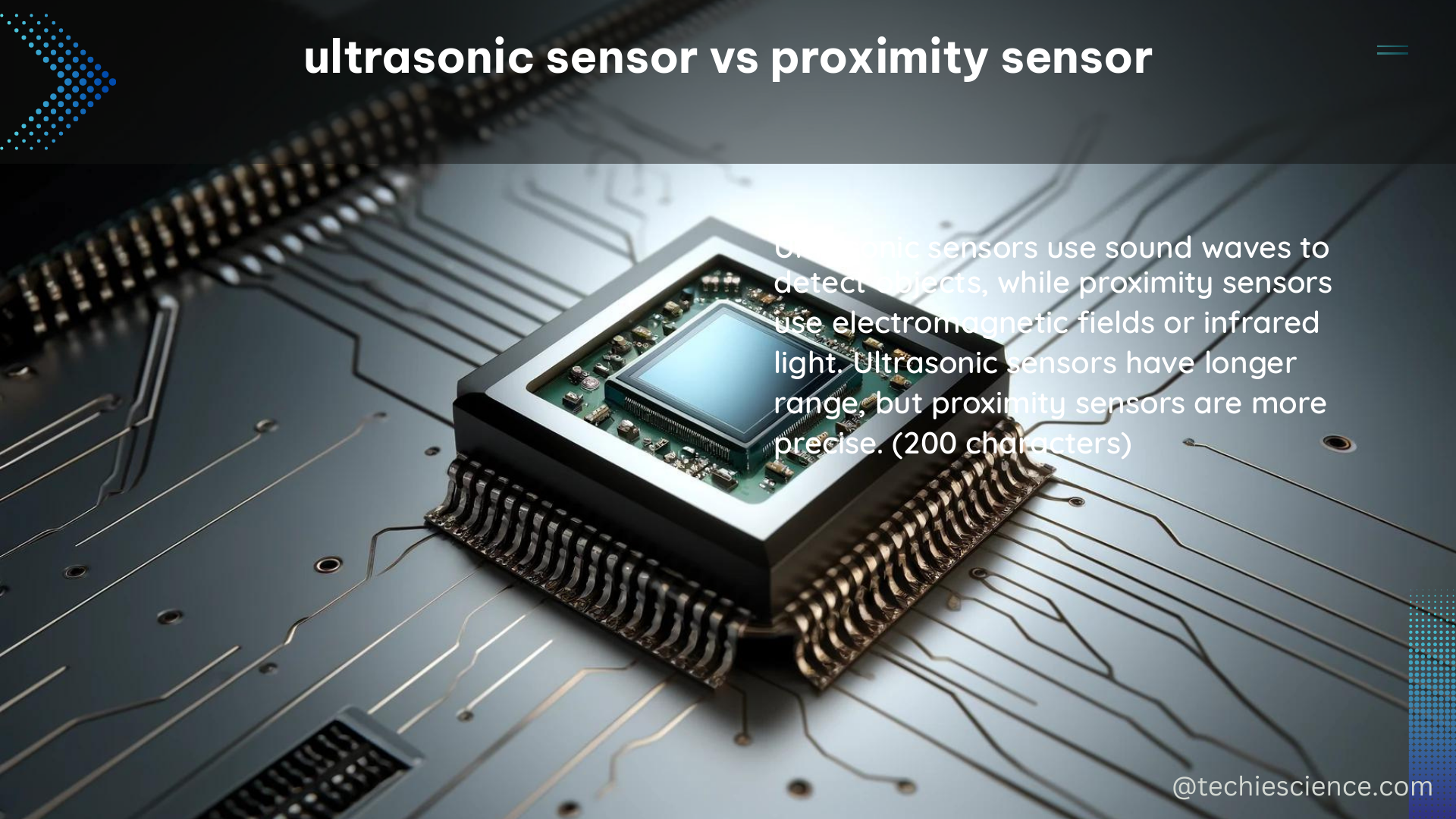Ultrasonic sensors and proximity sensors are both widely used for distance measurement and object detection, but they differ in their underlying principles, performance characteristics, and suitability for various applications. This comprehensive guide will delve into the intricacies of these two sensor technologies, equipping you with the knowledge to make an informed decision on which one best suits your needs.
Measurement Principle
Ultrasonic Sensors:
Ultrasonic sensors emit high-frequency sound waves, typically in the range of 40 kHz to 400 kHz, and measure the time it takes for the sound to bounce back from an object. The distance is then calculated based on the speed of sound and the time delay between the emitted and received signals. This principle is known as the Time-of-Flight (ToF) method.
Proximity Sensors:
Proximity sensors, on the other hand, use various electromagnetic or optical methods to detect the presence or absence of an object without direct contact. These methods include:
– Inductive Proximity Sensors: Detect metallic objects by creating an electromagnetic field and sensing changes in the field when an object enters the sensing range.
– Capacitive Proximity Sensors: Detect both metallic and non-metallic objects by measuring changes in the electrical capacitance between the sensor and the object.
– Photoelectric Proximity Sensors: Detect objects by emitting and receiving infrared or visible light, and sensing the reflection or interruption of the light beam.
Accuracy and Range

Ultrasonic Sensors:
Ultrasonic sensors can measure distances with high accuracy, typically within a range of a few millimeters to several meters, depending on the specific model and settings. They are less affected by the color or transparency of the object, but their performance can be influenced by factors such as temperature, humidity, and air turbulence.
For example, the MaxBotix LV-MaxSonar-EZ0 ultrasonic sensor has a resolution of 1 inch and a range of 6 inches to 254 inches, with a read rate of 20 Hz. The MaxBotix XL-MaxSonar-WRMA1 model can measure distances from 20 cm to 765 cm, with a read rate of 10 Hz and various output options, including analog voltage, analog envelope, and RS232 serial.
Proximity Sensors:
Proximity sensors generally have a shorter range, typically within a few centimeters to a few meters, and their accuracy may depend on the reflectivity or transparency of the target object. They are less affected by temperature and humidity, but can be influenced by the presence of other electromagnetic fields or interference.
For example, the Sharp GP2Y0A21YK0F proximity sensor has a range of 20 cm to 150 cm, with an analog voltage output and a 5 V DC power supply. The Vishay TCRT5000L infrared reflective sensor has a range of 0 mm to 15 mm, while the Panasonic EKMC16011121 Hall effect sensor can detect objects within a 0 mm to 10 mm range.
Environmental Factors
Ultrasonic Sensors:
Ultrasonic sensors are generally more robust and can operate in harsh environments with dust, smoke, fog, or other contaminants. They are also less affected by the color or transparency of the target object, as they rely on the reflection of sound waves rather than light.
However, ultrasonic sensors can be influenced by factors such as temperature, humidity, and air turbulence, which can affect the speed of sound and the accuracy of the distance measurements. Proper calibration and compensation for environmental conditions are often necessary to maintain the sensor’s performance.
Proximity Sensors:
Proximity sensors are more sensitive to electromagnetic interference and may require shielding or filtering to ensure reliable operation. They can also be affected by the reflectivity or transparency of the target object, especially in bright or dark conditions, which can impact the sensor’s ability to detect the object accurately.
Proximity sensors, on the other hand, are generally less affected by temperature and humidity, as they do not rely on the propagation of sound waves. This makes them more suitable for applications where environmental conditions are more stable or predictable.
Technical Specifications
Here are some detailed technical specifications for popular ultrasonic and proximity sensors:
Ultrasonic Sensors:
– MaxBotix LV-MaxSonar-EZ0: 1-inch resolution, 6 inches to 254 inches range, 20 Hz read rate, pulse-width, analog voltage, or RS232 serial output
– MaxBotix XL-MaxSonar-WRMA1: 20 cm to 765 cm range, 10 Hz read rate, analog envelope, analog voltage, or RS232 serial output
– MaxBotix HRUSB-MaxSonar-EZ0: Millimeter resolution, 20 cm to 550 cm range, USB interface, Windows and Linux drivers available
Proximity Sensors:
– Sharp GP2Y0A21YK0F: 20 cm to 150 cm range, analog voltage output, 5 V DC power supply
– Vishay TCRT5000L: 0 mm to 15 mm range, infrared reflective sensor, 5 V DC power supply
– Panasonic EKMC16011121: 0 mm to 10 mm range, Hall effect sensor, 5 V DC power supply
Conclusion
Ultrasonic sensors and proximity sensors each have their own unique strengths and weaknesses, making them suitable for different applications. Ultrasonic sensors excel in long-range distance measurement and are more robust in harsh environments, while proximity sensors offer shorter-range detection and are less affected by environmental factors.
When choosing between these two sensor technologies, it’s essential to consider the specific requirements of your application, such as the required measurement range, accuracy, environmental conditions, and the nature of the target objects. By understanding the underlying principles and technical specifications of ultrasonic and proximity sensors, you can make an informed decision that best fits your project’s needs.
References:
- Is an Ultrasonic Sensor or Infrared Sensor Better for Measuring Distance to/from an Object?
- Ultrasonic or Infrared Sensors
- Statistical analysis of sensor data for different obstacle materials

The lambdageeks.com Core SME Team is a group of experienced subject matter experts from diverse scientific and technical fields including Physics, Chemistry, Technology,Electronics & Electrical Engineering, Automotive, Mechanical Engineering. Our team collaborates to create high-quality, well-researched articles on a wide range of science and technology topics for the lambdageeks.com website.
All Our Senior SME are having more than 7 Years of experience in the respective fields . They are either Working Industry Professionals or assocaited With different Universities. Refer Our Authors Page to get to know About our Core SMEs.